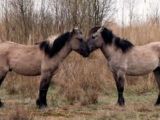Scientists have discovered what appears to be the remains of horse corrals beside pit houses from 5,600 years ago at Krasnyi Yar in Kazakhstan.
The site corresponds to Botai culture of the Eurasian Steppe, probably a Proto Indo-European population, who relied on horses for food, tools, and transport. "There's very little direct evidence of horse domestication," says Sandra Olsen, an archaeologist and horse domestication researcher at the Carnegie Museum of Natural History in Pittsburgh, PA. That's because 5,600 years ago there were no saddles or metal bits to leave behind. Equipment like bridles, leads, and hobbles would have been made from thongs of horse hide, and would have rotted away long ago. Likewise horses themselves have not changed much physically as a result of domestication, unlike dogs or cattle. So ancient horse bones don't easily reveal the secrets of domestication."
So the scientists had to look for circumstantial evidence that people had domesticated horses. Subtle electrical and magnetic irregularities in the soils pointed the locations of 54 pit houses and dozens of post moulds indicating the location of ancient vertical posts. Some moulds were put circularly, as for a corral.
Soil samples from inside the corral area and outside the settlement were analyzed for nitrogen, phosphorus, potassium, and sodium concentrations by a team led by geochemist Rosemary Capo at University of Pittsburgh.
Horse manure is rich in phosphorous, potassium, and especially nitrogen, compared to normal soils.
Nitrogen is a very mobile element and it can be washed out to groundwater by rainfalls or released to the atmosphere by organic and inorganic processes.
Phosphorus is much less mobile and usually forms combinations with calcium and iron which stay on place for millennia. The analysis found a phosphorus concentration ten times greater on the soil inside the settlement compared to the soils from outside the settlement. "Lots of phosphorus can also indicate a hearth, said Capo, but that phosphorus is usually accompanied by a lot of potassium, which is not the case in the corral at Krasnyi Yar."
"The corral soils also had low nitrogen concentrations, says Capo, reducing the likelihood that the phosphorus came from more recent manure."
"Even more compelling will be if we find long-lived molecules of fat directly attributed to horse manure in the soils," says Olsen.
"Early as the Botai were, they were probably not the first to domesticate horses. The very first horse domestication was probably a bit earlier in Ukraine or western Russia," says Olsen.
"Then some horse-herders migrated east to Kazakhstan."
Horse breeding allowed the Botai people to build large sedentary villages with hundreds of homes in some cases. "They did so without the benefit of agriculture, Olsen explained, as theirs was a horse economy."
Horse's resistance to cold was the key of this life style. "Horses can survive ice storms and don't need heated barns or winter fodder. Olsen said. They are, in fact, some of the last remaining large, Ice Age, Pleistocene mammals living in one of the last places on Earth where Pleistocene vegetation survives."
Domesticated horses supplied meat year-round and vitamin-rich mare's milk from spring through fall. Remains of heavy material, like rocks and large skulls, possessed by Botai people indicated that they relied on horses for transport. "Later people of the same region adopted shepherding and cattle raising," said Olsen.
Sheep and cattle are not well suited for sub-zero climates and are much more selective about food, so this started a nomadic culture characterized by transhumance. "The tradeoff, she says, was that cows and sheep give far fattier milk year round, which can be made into yogurt and cheese. Sheep also provide wool."
"Kazakh people today still eat horsemeat. They were forced to abandon their nomadic lifestyle during the Soviet era and have returned to small village pastoralism," Olsen says. But today, mongoloid Kazakh people are not the same with the Caucasoid ancient Botai people.
Image credit: Rosemary Capo, Sandra Olsen. Botai village reconstructed
Photo: bred-back tarpans (primitive horses close to the horses of Botai people)

 14 DAY TRIAL //
14 DAY TRIAL // 
